Are you a streamer looking to elevate your audio quality and engagement? With the rise of live streaming platforms, having top-notch audio has become essential for attracting and retaining viewers. A high-quality audio interface can significantly improve your sound, reducing background noise and ensuring a professional listening experience.
Here are few key factors to consider while buying best audio interfaces for streaming:
- Audio Resolution: Opt for interfaces with at least 24-bit depth and 96 kHz sample rate for superior clarity and detail.
- Gain Range: Choose interfaces offering a minimum of 55 dB gain to accommodate a variety of microphones and sound sources effectively.
- Latency: Look for interfaces that ensure low latency, ideally below 5 milliseconds, to allow real-time feedback and seamless audience interaction.
In this article, we’ve put together a list of the top audio interfaces for streaming. Check out our “Buying Guide” for more details.
Outline
Toggle9 Best Audio Interfaces For Streaming Table
| Product Name | No.of Channels | Audio Resolution | Buy Now |
|---|---|---|---|
| Focusrite Scarlett 2i2 3rd Gen | 2 | 24-bit/192kHz | Check On Amazon |
| M-Audio M-Track Solo | 2 | 48kHz | Check On Amazon |
| PreSonus AudioBox 96 | 2 | 24-bit/96kHz | Check On Amazon |
| MAONO AU-AM200-S1 Audio Interface | 9 | 16bit/48kHz | Check On Amazon |
| IK Multimedia iRig Stream Pro | 4 | 24-bit/96kHz | Check On Amazon |
| Behringer U-Phoria UMC404HD | 4 | 24-bit/192kHz | Check On Amazon |
| Universal Audio Volt 1 | 1 | 24-bit/192kHz | Check On Amazon |
| MOTU M2 2x2 USB-C Audio Interface | 2 | 24-bit/192kHz | Check On Amazon |
| Wrugste USB Audio Interface | 2 | 24-bit/192kHz | Check On Amazon |
9 Best Audio Interfaces For Streaming Reviews
1. Focusrite Scarlett 2i2 3rd Gen
Best For: Home Studios, Podcasters, Singer-Songwriters

With exceptional clarity, the Scarlett 2i2 3rd Gen by Focusrite is renowned for its high-performance preamps, making it a favorite in both home and professional studios. Its standout feature, the “Air” mode, emulates the classic ISA preamp, offering a crisp and open sound, especially for vocals and acoustic instruments. This capability is rare at its price point, making the Scarlett 2i2 more than just an audio interface—it’s a pathway to professional-grade recording.
One of the key strengths of this model is its ability to handle high-headroom instrument inputs without distortion. It also features dual balanced outputs, ensuring clean and accurate audio playback. Despite its compact size, the Scarlett 2i2 is powerful, equipped with 24-bit/192kHz converters to guarantee high-quality recordings. However, it does have some limitations, such as the absence of MIDI inputs and a limited number of channel inputs, which might not meet the needs of more complex setups.
Nevertheless, for solo artists, podcasters, and streaming enthusiasts, the Scarlett 2i2 offers exceptional quality and value. Its user-friendly design and robust build make it an ideal choice for those venturing into music production, providing a seamless setup with impressive results. This interface continues to be a top contender in the market, well-suited for anyone looking to achieve professional sound at an accessible price.
Specifications:
- Inputs/Outputs: 2-in/2-out
- Preamps: Two upgraded Scarlett mic preamps
- Audio Resolution: 24-bit/192kHz
- Connectivity: USB-C
- Phantom Power: Yes, +48V
- Direct Monitoring: Yes, switchable
- Included Software: Ableton Live Lite, Pro Tools | First Focusrite Creative Pack
- Build: Durable metal chassis
- Extra Features: AIR mode to add brightness
Pros:
- Crystal-clear audio quality with minimal noise
- Durable metal chassis built to last
- Easy setup suitable for beginners
- Versatile “Air” feature enhances recordings
- Comes with a rich bundle of recording software
Cons:
- Lacks MIDI connectivity
Customer Feedback: Users praise its improved preamps and high-resolution audio for delivering crisp recordings, though some mention issues with driver stability on certain operating systems.
2. M-Audio M-Track Solo
Best For: Beginners, Simple Home Recording Setups
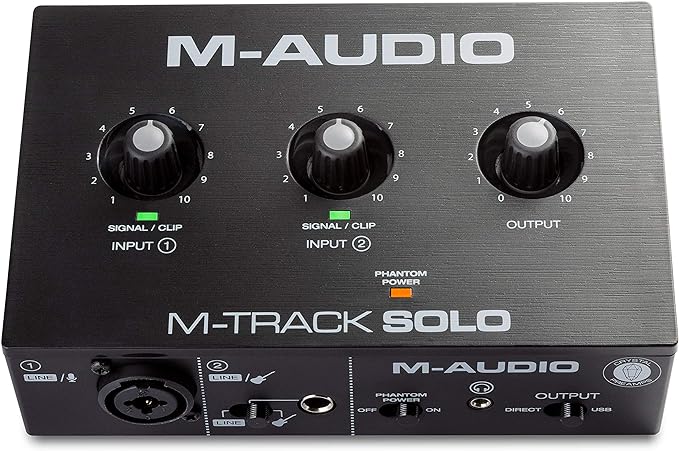
The Crystal Preamp, featured in the M-Track Solo, makes this M-Audio interface a top pick for beginners, offering clear and precise microphone audio. Designed with beginners in mind, this interface offers a reliable solution for home recording tasks, ensuring high-quality audio at 48 kHz. Its direct monitoring feature allows for latency-free recording, essential for capturing vocals or instruments in real time.
This versatile interface supports both XLR and 1/4″ instrument inputs, accommodating various recording needs. It comes with a robust software package, including MPC Beats, providing all the tools necessary to start recording immediately. While it doesn’t boast the advanced features of higher-end models, the M-Track Solo is perfect for those who prioritize simplicity and effectiveness in their recording setup.
Ideal for podcasters, solo musicians, and digital content creators, the M-Track Solo offers a straightforward yet powerful recording experience. Its combination of essential features and user-friendly design makes it an excellent choice for producing high-quality audio without the hassle of complex settings.
Specifications:
- Inputs/Outputs: 2-in/2-out
- Preamps: Crystal Preamp for microphone
- Audio Resolution: 48kHz audio resolution
- Connectivity: USB
- Phantom Power: Yes, +48V
- Direct Monitoring: Yes
- Included Software: MPC Beats, AIR Music Tech Xpand!2
- Build: Compact and rugged design
- Extra Features: Dedicated instrument input
Pros:
- Excellent audio clarity with Crystal Preamps
- Simple, intuitive operation perfect for beginners
- Compact and portable design
- Affordable price point with great value
- Comprehensive software bundle included
Cons:
- Limited input options with only one microphone input
Customer Feedback: Appreciated for its affordability and ease of use for beginners; however, some users report challenges with durability and compatibility with various DAWs.
3. PreSonus AudioBox 96
Best For: Musicians and Podcasters on a Budget
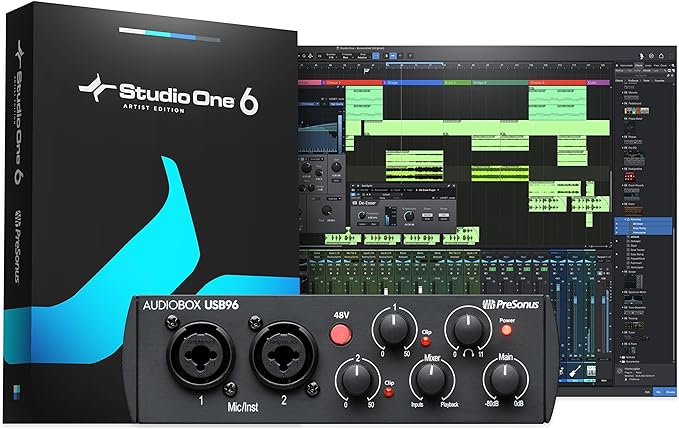
When considering an audio interface that can handle the demands of travel and still perform consistently, the PreSonus AudioBox 96 is a top option. Its durable build and reliable output make it ideal for musicians and podcasters who need equipment they can trust on the go. The interface is equipped with dual Class-A mic preamps, which capture recordings with clear and accurate sound. With its 24-bit/96 kHz recording capabilities, it delivers the professional-level audio quality that one might expect from more expensive gear.
The AudioBox 96 is designed for ease of use, featuring a simple front panel with a mixer control that allows users to blend the input signal with computer playback for zero-latency monitoring. This feature is especially valuable in recording situations where hearing yourself in real-time is essential. Additionally, its USB-powered design enhances portability by removing the need for an external power source, making it ideal for mobile setups or on-the-go recording.
While it may lack some advanced connectivity options found in higher-end models, the AudioBox 96 shines in providing a straightforward, reliable recording experience. It’s a solid choice for entry-level and intermediate users who require a dependable, no-nonsense interface that delivers consistent results.
Specifications:
- Inputs/Outputs: 2-in/2-out
- Preamps: Two Class-A mic preamps
- Audio Resolution: 24-bit/96kHz
- Connectivity: USB 2.0
- Phantom Power: Yes, +48V
- Direct Monitoring: Mix control to blend input and computer playback
- Included Software: Studio One Artist and Studio Magic Plug-in Suite
- Build: Heavy-duty steel chassis
- Extra Features: MIDI I/O
Pros:
- Excellent audio quality with professional resolution
- Durable construction suitable for travel
- Easy installation and setup process
- Comes with a comprehensive software bundle
- Affordable price for the features offered
Cons:
- No USB-C connection
Customer Feedback: Well-regarded for its solid build and comprehensive software bundle, but some users find the preamps to be noisy at higher gain settings.
4. MAONO AU-AM200-S1 Audio Interface
Best For: Streaming, Live podcasting, Versatile Setups
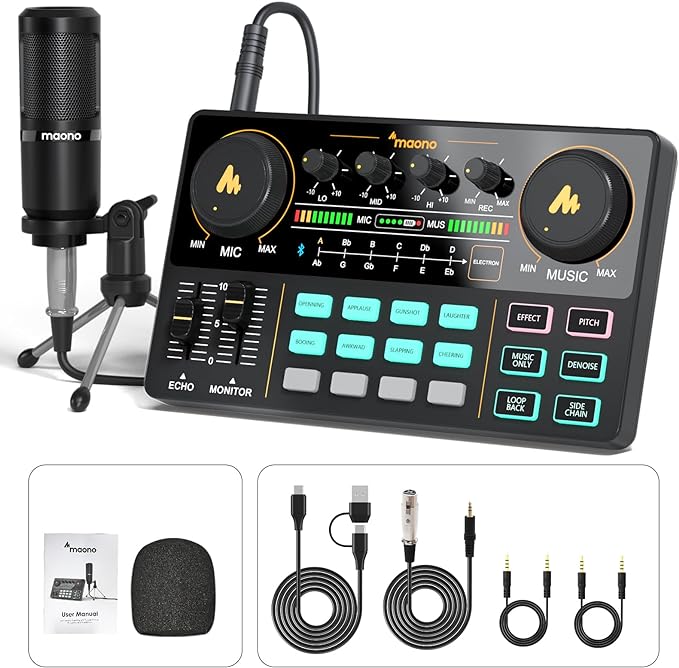
For those in the podcasting and streaming world, the AU-AM200-S1 by MAONO offers a versatile audio interface designed to elevate broadcasts. Supporting up to two users across four devices, it integrates seamlessly with multiple platforms, making it ideal for live streaming and podcasting across various media channels.
One of the most appealing aspects of the MAONO AU-AM200-S1 is its real-time voice-changing feature, which allows users to add both fun and professional effects to their audio. With intuitive controls for mixing various audio inputs, this interface is user-friendly and easy to integrate into any setup. Its compact design, along with Bluetooth and AUX connectivity, adds to its flexibility, making it suitable for both studio environments and mobile use.
However, the MAONO AU-AM200-S1 does have some limitations. It relies heavily on digital adjustments, which may not provide the level of control that more experienced audio technicians might desire. Nevertheless, for its intended audience, it offers a robust set of features that are practical and accessible, making it a valuable tool for enhancing online interactions.
Specifications:
- Inputs/Outputs: Multiple input options including Bluetooth
- Preamps: Low noise preamps
- Audio Resolution: High-resolution audio support
- Connectivity: USB, AUX, Bluetooth
- Phantom Power: Not specified
- Direct Monitoring: Yes
- Included Software: No software included
- Build: Integrated audio mixer and sound effects
- Extra Features: Real-time voice changer and sound effects
Pros:
- Comprehensive feature set tailored for live streaming and podcasting
- Portable and includes all necessary accessories for immediate setup
- Intuitive interface with easy-to-use controls
- Offers both wired and wireless connectivity options
- Affordable price with significant value for content creators
Cons:
- Audio adjustments may lack precision for professional users
Customer Feedback: Popular for podcasters due to its versatile inputs and built-in effects; some users express concerns over the complexity of setup and occasional software bugs.
5. IK Multimedia iRig Stream Pro
Best For: Mobile Musicians, Live Streamers
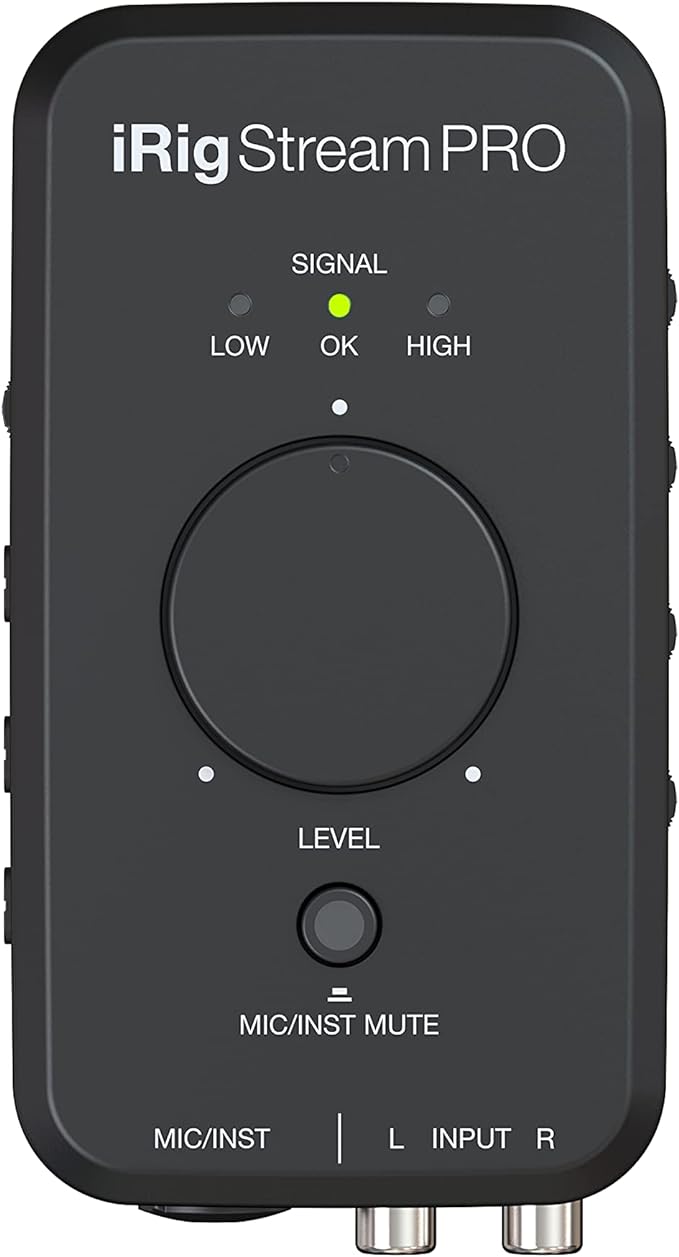
If you’re a content creator seeking mobile compatibility, look no further than the iRig Stream Pro, an audio interface crafted by IK Multimedia. This device excels in connecting smoothly with smartphones and tablets, which makes it a fantastic choice for podcasters and streamers who use these gadgets regularly. Featuring an XLR microphone preamp and stereo RCA inputs, it offers flexibility suitable for both professional and casual use.
This interface excels in providing a 24-bit, 96 kHz recording capability, ensuring studio-quality sound whether you’re podcasting, streaming, or recording music. The direct monitoring feature is particularly useful, allowing users to hear their sound in real-time, with no latency—an essential for live performances and broadcasts. The loopback function, which routes the output back into the mix, is perfect for creators who incorporate backing tracks or sound effects into their live sessions.
Despite its many strengths, the iRig Stream Pro is somewhat limited by its connectivity options and may require additional adapters for certain setups. However, its compact design and robust software compatibility make it a powerful tool for digital content creation on the go.
Specifications:
- Inputs/Outputs: Multiple routing options
- Preamps: High-quality preamps with phantom power
- Audio Resolution: 24-bit/96kHz
- Connectivity: USB, RCA, TRRS
- Phantom Power: Yes
- Direct Monitoring: Yes
- Included Software: Works with many apps and software
- Build: Compact and portable
- Extra Features: Loopback for easy streaming
Pros:
- High-quality preamp and converters ensure excellent sound
- Direct monitoring for real-time audio checks
- Versatile connectivity options for various devices
- Portable and easy to set up with mobile apps
- Loopback feature enhances live streaming capabilities
Cons:
- Some issues with app compatibility
Customer Feedback: Lauded for its mobile compatibility and easy setup for streaming; however, some report dissatisfaction with the overall build quality and audio latency.
6. Behringer U-Phoria UMC404HD
Best For: Multi-Instrument Recording, Bands

The UMC404HD, a U-Phoria USB audio interface from Behringer, offers outstanding value, making it a top pick for musicians and podcasters seeking high performance on a budget. This interface’s four MIDAS preamps provide crystal-clear audio that stands up to more expensive competitors. Additionally, the UMC404HD supports high-resolution 24-bit/192kHz recording, ensuring that every nuance of your sound is captured in rich detail.
This model stands out with its comprehensive I/O capabilities, including four inputs and outputs with inserts for external processing. This level of connectivity allows users to set up complex recording sessions, accommodating everything from microphones and instruments to outboard gear. MIDI I/O is also included, adding further versatility for producers working with MIDI hardware.
While the UMC404HD is packed with features, some users may find the interface’s software compatibility and driver stability lacking compared to other brands. However, for those willing to navigate these minor challenges, the UMC404HD offers unbeatable functionality and audio quality at its price point.
Specifications:
- Inputs/Outputs: 4-in/4-out
- Preamps: Four MIDAS-designed mic preamps
- Audio Resolution: 24-bit/192kHz
- Connectivity: USB 2.0
- Phantom Power: Yes, +48V for each input
- Direct Monitoring: Zero-latency monitoring
- Included Software: Compatible with most DAWs
- Build: Impact-resistant metal chassis
- Extra Features: MIDI I/O and analog inserts
Pros:
- Excellent audio quality with professional-grade preamps
- Extensive I/O options for versatile connectivity
- Affordable price point offers great value
- Durable build suitable for both studio and live use
- Easy integration with most digital audio workstations
Cons:
- Lacks onboard DSP for real-time effects processing
Customer Feedback: Users appreciate the interface’s multiple inputs and MIDAS preamps for their clear sound, but some have experienced reliability issues over time.
7. Universal Audio Volt 1
Best For: Professional Solo Musicians, High-Quality Streaming
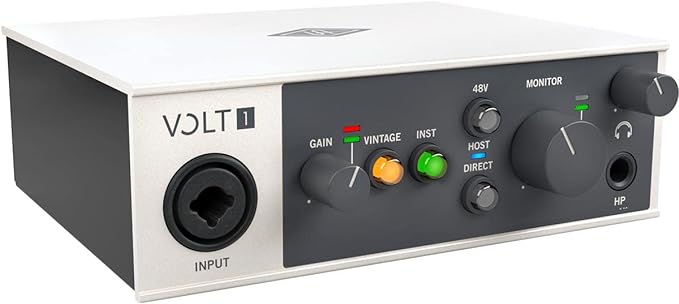
For those who appreciate vintage sound quality, the Universal Audio Volt 1 is a compact and affordable audio interface that brings legendary preamp emulation right to your fingertips. The Vintage Mic Preamp mode is the highlight, offering an emulation of the UA 610 tube preamp, celebrated for its warm, rich sound in countless classic tracks.
Built for simplicity, the Volt 1 offers a straightforward setup with one input and two outputs, combined with high-class audio conversion technology to ensure pristine sound. It’s particularly appealing for those looking to capture high-quality vocals or acoustic instruments directly into their digital audio workstation without complex configurations.
The inclusion of robust software like Ableton and Melodyne makes the Volt 1 even more versatile, providing users with a suite of tools for detailed sound shaping and production right out of the box. Despite its straightforward design, some may find the single input limiting, but for solo artists or podcast hosts, it offers unparalleled audio quality and ease of use in its class.
Specifications:
- Inputs/Outputs: 1-in/2-out
- Preamps: Vintage Mic Preamp mode
- Audio Resolution: 24-bit/192kHz
- Connectivity: USB-C
- Phantom Power: Yes, +48V
- Direct Monitoring: Yes
- Included Software: Bundled with industry-leading software
- Build: All-metal construction
- Extra Features: Built-in tube emulation circuitry
Pros:
- Exceptional audio quality with vintage preamp emulation
- Compact and sturdy design ideal for mobile setups
- Comes with a high-quality software bundle
- USB bus power allows for recording anywhere
- Easy to use, perfect for beginners and professionals alike
Cons:
- USB-C connectivity may require adapters for older computers
Customer Feedback: Praised for its exceptional audio quality and vintage preamp emulation, but its higher price point and limited I/O options have been noted as drawbacks by some users.
8. MOTU M2 2×2 USB-C Audio Interface
Best For: Professional Studios, Advanced Producers

The MOTU M2 USB-C Audio Interface excels with its outstanding audio clarity, powered by the renowned ESS Sabre32 Ultra DAC technology, offering a 120 dB dynamic range. Whether you’re a seasoned professional or an enthusiastic hobbyist, this interface ensures top-tier audio quality with ultra-low latency, making it ideal for accurate recording and monitoring.
The 2-in/2-out configuration in this model allows simultaneous recording and playback of two channels with independently controllable headphone and monitor outputs, making it ideal for singer-songwriters and podcasters. Its best-in-class speed ensures monitoring of live inputs through your computer is virtually latency-free, which is critical for real-time audio applications.
The full-color LCD with detailed metering provides instant visual feedback of input and output levels, setting the MOTU M2 apart from its competitors in usability and functionality. While the interface is highly praised for its sound quality and performance, some users might find the front-placed inputs less desirable for cable management. Overall, the MOTU M2 combines high-end features in a compact and user-friendly package, making it a top choice for those upgrading their home studios.
Specifications:
- Inputs/Outputs: 2-in/2-out
- Preamps: High-quality ESS Sabre32 Ultra DAC technology
- Audio Resolution: 24-bit/192kHz
- Connectivity: USB-C
- Phantom Power: Yes, +48V
- Direct Monitoring: Yes, with detailed LCD metering
- Included Software: Compatibility with major DAWs
- Build: Robust, compact design
- Extra Features: Ultra-low latency performance
Pros:
- Outstanding audio quality with high dynamic range.
- Ultra-low latency perfect for live monitoring.
- Compact and durable design suitable for studio and mobile use.
- Intuitive full-color LCD metering.
- Comprehensive compatibility with major DAWs.
Cons:
- Some compatibility issues with specific software.
Customer Feedback: Celebrated for its ultra-low latency and excellent metering capabilities, though the front-placed inputs are occasionally cited as a design flaw.
9. Wrugste USB Audio Interface
Best For: Beginners, Budget-Conscious Users
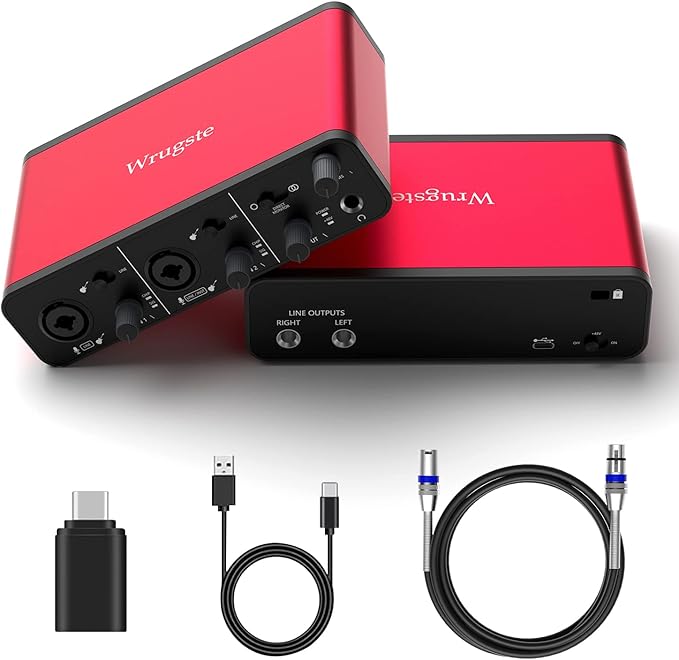
If affordability and decent audio quality are your top priorities, Wrugste’s USB Audio Interface is a product worth considering, especially for beginners. With 2-in-2-out connectivity, it supports both XLR and ¼” jack inputs, making it versatile for connecting microphones and instruments. Its 24-bit/192kHz conversion provides clean and clear audio, which is impressive given its affordable price.
A key feature of the Wrugste interface is its +48V phantom power, which allows it to support studio condenser microphones, enhancing the quality of your recordings. The direct monitoring feature is particularly useful, offering zero-latency tracking that ensures what you play is exactly what you hear in real-time, which is crucial for live recording sessions.
While the Wrugste interface covers the basics well, there are some concerns about its build quality and durability under heavy use. Those seeking more advanced, professional features might find it somewhat limited. However, for simple home recording setups, this interface offers exceptional value and meets the needs of entry-level users effectively.
Specifications:
- Inputs/Outputs: 2-in/2-out
- Preamps: Standard preamps with +48V phantom power
- Audio Resolution: 24-bit/192kHz
- Connectivity: USB-C
- Phantom Power: Yes, +48V
- Direct Monitoring: Yes, with MONO/STEREO switch
- Included Software: Compatible with major DAWs
- Build: Sturdy aluminum construction
- Extra Features: Portable and easy to use
Pros:
- Very affordable, offering great value for money.
- High-resolution audio suitable for basic recording tasks.
- Direct monitoring enables real-time, no-latency playback.
- Easy to use, especially for beginners.
- Portable and compatible with various recording software.
Cons:
- Build quality may not withstand rigorous, long-term use.
Customer Feedback: Valued for its cost-effectiveness and good audio quality for simple setups, but some users mention inconsistencies in build quality and driver support.
Factors To Consider While Buying The Best Audio Interface For Streaming
1. Audio Resolution
The audio resolution of an audio interface determines the quality of the sound you can capture and reproduce. This is measured in bit depth and sample rate. For streaming, a minimum of 24-bit/48kHz is generally sufficient to deliver high-quality audio. However, if you aim for professional-grade sound or want to future-proof your setup, consider interfaces offering higher bit depths and sample rates, such as 32-bit float and 96kHz or even 192kHz. These settings capture more audio detail, resulting in a richer and more immersive listening experience for your audience.
2. Gain Range
Gain range refers to the interface’s ability to amplify weak input signals. A suitable gain range for streaming is typically between 50 and 70 decibels (dB). This ensures you can effectively boost microphone signals without introducing noise. Insufficient gain might result in a quiet or distorted audio output, while excessive gain can lead to noise and clipping.
3. Latency
Latency, the delay between input and output, is critical for real-time applications like streaming. Aim for an audio interface with a latency of less than 2 milliseconds to ensure seamless performance and prevent audio-visual sync issues. Low latency is crucial for live performances, gaming, and interactive streaming formats.
4. Phantom Power
Phantom power is a voltage supplied through microphone cables to power condenser microphones. If you plan to use condenser microphones, your interface must have 48V phantom power. Check if the interface offers switchable phantom power to accommodate different microphone types.
5. Connectivity
Connectivity options determine how the interface interacts with your computer. USB is the most common and widely compatible choice, offering various speeds (USB 2.0, 3.0, or C). Thunderbolt provides high-speed data transfer for demanding applications, while Firewire is still used in some professional setups. Consider your computer’s ports and the number of devices you need to connect when selecting connectivity.
6. Number Of Channels
The number of channels determines how many input and output sources you can connect simultaneously. For basic streaming setups, a 2-channel interface might suffice. However, as your setup grows to include multiple microphones, instruments, or other audio sources, consider interfaces with more channels. Popular options range from 4 to 18 channels, accommodating various streaming scenarios.
7. Sound Effects
While not strictly related to audio quality, sound effects can enhance your stream’s engagement and production value. Consider an audio interface with onboard digital signal processing (DSP) capabilities that offer built-in effects like reverb, delay, and equalization. Alternatively, look for interfaces that integrate seamlessly with popular digital audio workstation (DAW) software, providing access to a vast array of virtual effects. This allows you to add creative touches to your audio and create a unique sound for your stream.
8. Compatible Devices
Ensure the audio interface is compatible with your operating system (Windows, macOS, iOS, Android). Some interfaces are specifically designed for computers, while others offer compatibility with mobile devices for on-the-go streaming. Consider your preferred streaming setup when choosing an interface.
FAQs:
An audio interface is a device that converts analog audio signals (from microphones, instruments, etc.) into digital signals that your computer can understand. For streamers, it’s essential for capturing high-quality audio, reducing background noise, and providing better overall sound quality for your audience.
Budget interfaces offer basic features for beginners or those on a tight budget. They typically have fewer inputs and less advanced preamps. High-end interfaces provide superior sound quality, more inputs, and advanced features like DSP processing for professional-level results.
Low latency means there’s a minimal delay between your audio input and output. This is crucial for real-time monitoring, preventing echo or feedback, and ensuring a smooth listening experience for your audience.
Yes, most audio interfaces have headphone outputs. This allows you to monitor your audio without disturbing your environment and helps you maintain consistent sound levels.
USB interfaces are more common and affordable, while Thunderbolt offers higher data transfer speeds and lower latency, making it a better choice for demanding applications or when using multiple high-resolution audio devices.
DSP (Digital Signal Processing) is a technology built into some audio interfaces that allows you to apply effects like compression, equalization, and reverb directly on the interface without overloading your computer’s CPU.
A mixer allows you to combine multiple audio sources (microphones, instruments, etc.) before sending them to your audio interface. This can be useful for more complex setups and provides additional control over your audio levels.
Conclusion
Your streaming success can be boosted with the right audio interface. These nine products provide a range of features suited for different needs and budgets. Whether you need something straightforward or more advanced, there’s an interface here that can elevate your audio quality and overall streaming performance.
Top 3 Recommendations:
- Focusrite Scarlett 2i2 3rd Gen – Best for those who need high-quality recordings with simple, reliable functionality.
- MOTU M2 – Ideal for musicians and content creators who prioritize low latency and precise metering.
- Behringer U-Phoria UMC404HD – Great for home studio setups that require multiple inputs and flexible connectivity options.

